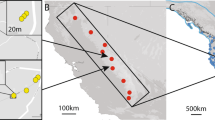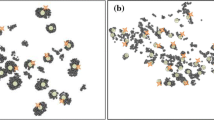Abstract
One of the most pressing issues in spatial genetics concerns sampling. Traditionally, substructure and gene flow are estimated for individuals sampled within discrete populations. Because many species may be continuously distributed across a landscape without discrete boundaries, understanding sampling issues becomes paramount. Given large-scale, geographically broad conservation efforts, researchers are looking for guidance as to the trade-offs between sampling more individuals within a population versus few individuals scattered across more populations. Here, we conducted simulations that address these issues. We first established two archetypical patterns of dispersion: (1) individuals within discrete populations, and (2) continuously distributed individuals with limited dispersal. We used genotypes generated from a spatially-explicit, individual-based program and simulated genetic structure in individuals from nine different population sizes across a landscape that either had barriers to movement (defining discrete populations) or isolation-by-distance patterns (defining continuously distributed individuals). Then, given each pattern of dispersion, we allocated samples across four different sampling strategies for each of the nine population sizes in various configurations for sampling more individuals within a population versus fewer individuals scattered across more populations. We assessed the population genetic substructure with both the population-based metric, F ST, and an individual-based metric, D PS regardless of the true pattern of dispersion to allow us to better understand the effect of incorrectly matching the metric and the distribution (e.g., F ST with continuously distributed individuals, and vice versa). We show that sampling many subpopulations (or sampling areas), thus sampling fewer individuals per subpopulation, overestimates measures of population subdivision with the population-based metric for both patterns of dispersion. In contrast, using the individual-based metric gives the opposite results: sampling too few subpopulations, and many individuals per subpopulation, produces an underestimate of the strength of isolation-by-distance. By comparing all results, we were able to suggest a strong predictive model of a chosen genetic structure metric for elucidating the sampling design trade-offs given each pattern of dispersion and configuration on the landscape.





Similar content being viewed by others
References
Balloux F (2001) EASYPOP (Version 1.7): a computer program for population genetic simulations. J Hered 92:301–302
Barton K (2012) http://mumin.r-forge.r-project.org/MuMIn-manual.pdf
Bowcock AM, Ruiz-Linares A, Tomfohrde J, Minch E, Kidd JR, Cavalli-Sforza LL (1994) High resolution of human evolutionary trees with polymorphic microsatellites. Nature 368:455–457
Bradburd GS, Ralph PL, Graham MC (2013) Disentangling the effects of geographic and ecological isolation on genetic differentiation. Evolution. doi:10.1111/evo.12195
Burnham KP, Anderson DR (2002) Model selection and multimodel inference: a practical information-theoretic approach, 2nd edn. Springer, New York
Dyer RJ, Nason JD, Garrick RC (2010) Landscape modelling of gene flow: improved power using conditional genetic distance derived from the topology of population networks. Mol Ecol 19:3746–3759
Goslee SC, Urban DL (2007) The ecodist package for dissimilarity-based analysis of ecological data. J Stat Softw 22:1–19
Graves TA, Beier P, Royle A (2013) Current approaches using genetic distances produce poor estimates of landscape resistance to interindividual dispersal. Mol Ecol. doi:10.1111/mec.12348
Guillot G, Rousset F (2011) On the use of simple and partial Mantel tests in the presence of spatial auto-correlation, arXiv:1112.0651v1
Hoffman EA, Kolm N, Berglund A, Arguello JR, Jones AG (2005) Genetic structure in the coral-reef-associated Banggai cardinalfish, Pterapogon kauderni. Mol Ecol 14:1367–1375
Landguth EL, Cushman SA (2010) CDPOP: a spatially-explicit cost distance population genetics program. Mol Ecol Resour 10:156–161
Landguth EL, Cushman SA, Murphy M, Luikart G (2010) Relationships between migration rates and landscape resistance assessed using individual-based simulations. Mol Ecol Resour 10:854–862
Landguth EL, Cushman SA, Johnson NJ (2012a) Simulating natural selection in landscape genetics. Mol Ecol Resour 12:363–368
Landguth EL, Fedy BC, Garey A, Mumma M, Emel S, Oyler-McCance S, Cushman SA, Wagner HH, Fortin M-J (2012b) Effects of sample size, number of markers, and allelic richness on the detection of spatial genetic pattern. Mol Ecol Resour 12:276–284
Legendre P, Fortin M-J (2010) Comparison of the Mantel test and alternative approaches for detecting complex multivariate relationships in the spatial analysis of genetic data. Mol Ecol Resour 10:831–844
Legendre P, Legendre L (2012) Numerical ecology, 3rd edn. Elsevier, Amsterdam
Mantel N (1967) The detection of disease clustering and a generalized regression approach. Cancer Res 27:209–220
Meirmans PG (2012) The trouble with isolation by distance. Mol Ecol 21:2839–2846
Murphy M, Evans J, Cushman SA, Storfer A (2008) Representing genetic variation as continuous surfaces: an approach for identifying spatial dependency in landscape genetic studies. Ecography 31:685–697
Nei M (1973) Analysis of gene diversity in subdivided populations. Proc Natl Acad Sci USA 70:3321
Nei M, Chesser R (1983) Estimation of fixation indices and gene diversities. Ann Hum Genet 47:253–259
Novembre J et al (2008) Genes mirror geography within Europe. Nature 456:98–101
Ott J (1992) Strategies for characterizing highly polymorphic markers in human gene mapping. Am J Hum Genet 51:283–290
Oyler-McCance SJ, Fedy BC, Landguth EL (2013) Sample design effects in landscape genetics. Conserv Genet 14:275–285
Purcell JFH, Cowen RK, Hughes CR, Willams DA (2006) Weak genetic structure indicates strong dispersal limits: a tale of two coral reef fish. Proc Royal Soc B 273:1483–1490
Rao C (2001) Sample size considerations in genetic polymorphism studies. Hum Hered 52:191–200
R Development Core Team (2012) R: a language and environment for statistical computing. R Foundation for Statistical Computing, Vienna. http://www.R-project.org
Rousset F (1997) Genetic differentiation and estimation of gene flow from F-statistics under isolation by distance. Genetics 145:1219–1228
Rousset F, Leblois R (2012) Likelihood-based inferences under a coalescent model of isolation by distance: two-dimensional habitats and confidence intervals. Mol Biol Evol 29:957–973
Schwartz MK, McKelvey KS (2009) Why sampling scheme matters: the effect of sampling scheme on landscape genetic results. Conserv Genet 10:441–452
Schwartz MK, Vucetich JA (2009) Molecules and beyond: assessing the distinctness of the Great Lakes wolf. Mol Ecol 18:2307–2309
Seeb JE, Carvalho G, Hauser L, Naish K, Roberts S, Seeb LW (2011) Single-nucleotide polymorphism (SNP) discovery and applications of SNP genotyping in nonmodel organisms. Mol Ecol Resour 11:1–8
Selkoe KA, Toonen RJ (2006) Microsatellites for ecologists: a practical guide to using and evaluating microsatellite markers. Ecol Lett 9:615–629
Siniscalco MR, Robledo PK, Bender C, Carcassi L, Contu L, Beck JC (1999) Population genomics in Sardinia: a novel approach to hunt for genomic combinations underlying complex traits and diseases. Cytogenet Cell Genet 86:148–152
Tucker JM, Schwartz MK, Truex RL, Pilgrim KL, Allendorf FW (2013a) Historical and contemporary DNA indicate fisher decline and isolation occurred prior to the European settlement of California. PLoS One. doi:10.1371/journal.pone.0052803
Tucker JM, Schwartz MK, Truex RL, Wisely SM, Allendorf FW (2013b) Sampling affects the detection of genetic subdivision and conservation implications for fisher in the Sierra Nevada. Conserv Genet. doi:10.1007/s10592-013-0525-4
Willing EM, Dreyer C, Oosterhout C (2012) Estimates of genetic differentiation measured by Fst do not necessarily require large sample sizes when using many SNP markers. PLoS One. doi:10.1371/journal.pone.0042649
Acknowledgments
We thank two anonymous reviewers for comments on this manuscript.
Author information
Authors and Affiliations
Corresponding author
Rights and permissions
About this article
Cite this article
Landguth, E.L., Schwartz, M.K. Evaluating sample allocation and effort in detecting population differentiation for discrete and continuously distributed individuals. Conserv Genet 15, 981–992 (2014). https://doi.org/10.1007/s10592-014-0593-0
Received:
Accepted:
Published:
Issue Date:
DOI: https://doi.org/10.1007/s10592-014-0593-0




